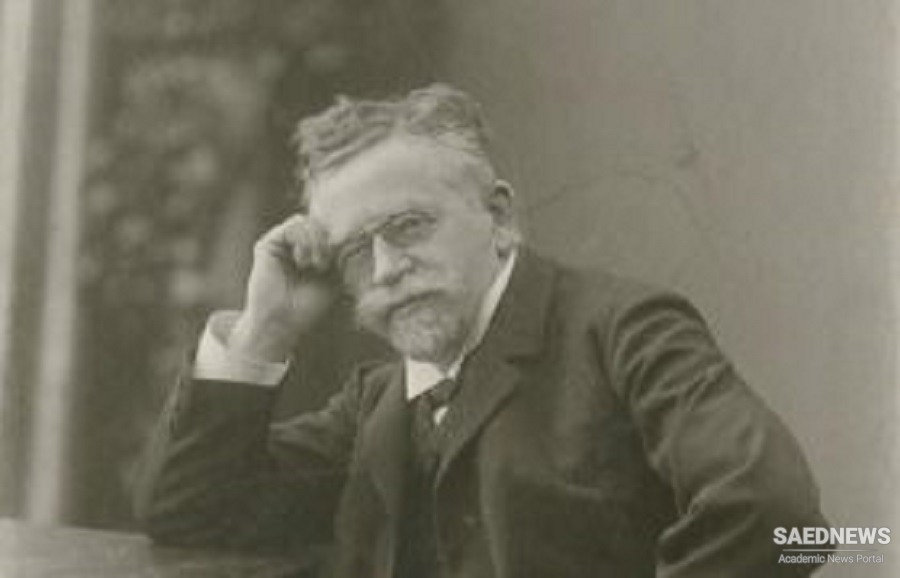From 1868 he pursued philological studies in Jena (with August Schlei-cher), Tübingen, Leipzig, and Munich, where in February 1872 he was awarded his doctorate. His thesis, on Yasna 30 of the Avesta, had been supervised by Martin Haug (q.v.) and was published under the title Ein Zoroastrisches Lied (1872). After further studies in Avestan texts and in grammatical and etymological problems of this language, from 1874 he turned more and more to Armenian, only to come back to diverse aspects of Iranian studies again and again. In that year he stayed on the island of San Lazzaro (Venice), site of the home monastery of the Mechitarist order, and he learned the Armenian language thoroughly with the monks. In 1875 he published a translation of the “Armenian History” written by Sebêos (Zur Geschichte Armeniens … des Sebêos, 1875). With this habilitation thesis he qualified as a university lecturer in Aryan (i.e., Indo-Iranian) languages at the University of Leipzig. In the following year he was appointed extraordinarius (associate professor) there, and from 1877 until his untimely death at the age of 59 he taught as full professor of comparative philology at the University of Strasbourg, which at that time was a German institution named afterWilhelm I, Kaiser-Wilhelms-Universität.
Hübschmann felt himself to be an orientalist. Originally an Iranian scholar, through his fundamental studies he became also the founder of modern Armenian linguist-ics; for it was he who created a solid basis for future historical-comparative research in this field. Altogether Hübschmann’s activity centered on three subjects: (1) studies about the Iranian languages, (2) Armenian studies, and (3) comparative philology of the Indo-European languages.
For the general public and for the historians of linguistic sciences the chief merit associated with his name is that he definitely proved that Armenian is an independent branch of the Indo-European family of languages (see Hübschmann, 1877 [but published already in 1875]) and does not belong to the Iranian languages; such was the prevailing, if not the universal, view at that time (cf. Schmitt, 1975), and it was forcefully propagated by Friedrich Müller and Paul de Lagarde. Hübschmann in fact went one step further and asserted that Armenian is not even part of the Aryan (Indo-Iranian) language group. Curiously enough he provided this proof in the lecture given for qua1ifying himself as a lecturer in Aryan languages.
From the point of view of Iranian studies this judgement of his merits is somewhat biased, however, because it neglects his second important achievement. Apart from the basic work he did for several Iranian languages, he was the first to ask what the term “Iranian” signifies; and by so doing he was practically the first to define the characteristic linguistic features of Iranian as a whole in contrast to the other Indo-European languages.
This development came about in this way: When Hübschmann familiarized himself with Armenian, it soon became clear to him that in its lexicon Armenian held a rather ambiguous position, by which he became somewhat disturbed. On the one hand there is a large number of Armenian words which are more or less identical with the corresponding Iranian and, more exactly, New Persian words; on the other hand there are a good many words which quite obviously are rather different, not only from their Iranian, but also from the other equivalents and which at the same time show profound peculiarities. The premise and the main principle guiding Hübschmann in this case was that any reliable statement about the true character of Armenian itself can be made only if it is based exclusively on material not borrowed. Therefore he eliminated from his analysis the countless Iranian (and other) borrowings and all words which are suspected of being borrowed. By this procedure he drew up the basic elements, as itwere, of “genuine” Armenian vocabulary; these words could be explained only as directly inherited from the Indo-European proto-language, because they had gone through particular phonological developments independent of, and quite different from, the Iranian ones. At the same time Hübschmann realized that in the Armenian nominal and verbal inflection nothing is found which looks specifically Iranian. The differentiation between inherited, “genuinely Armenian” (ech-tarmenische) words and several layers of borrowings (from Iranian languages, Greek, Syriac, etc.) was carried out for the first time by him; the analysis continued, even more systematically, so that at last his etymological dictionary of Armenian, in the only volume published of his Armenische Grammatik (1897), achieved the desired structure. It set a good example also for the analysis of other languages.


 Johannes Brahms: Aims and Achievements
Johannes Brahms: Aims and Achievements














































